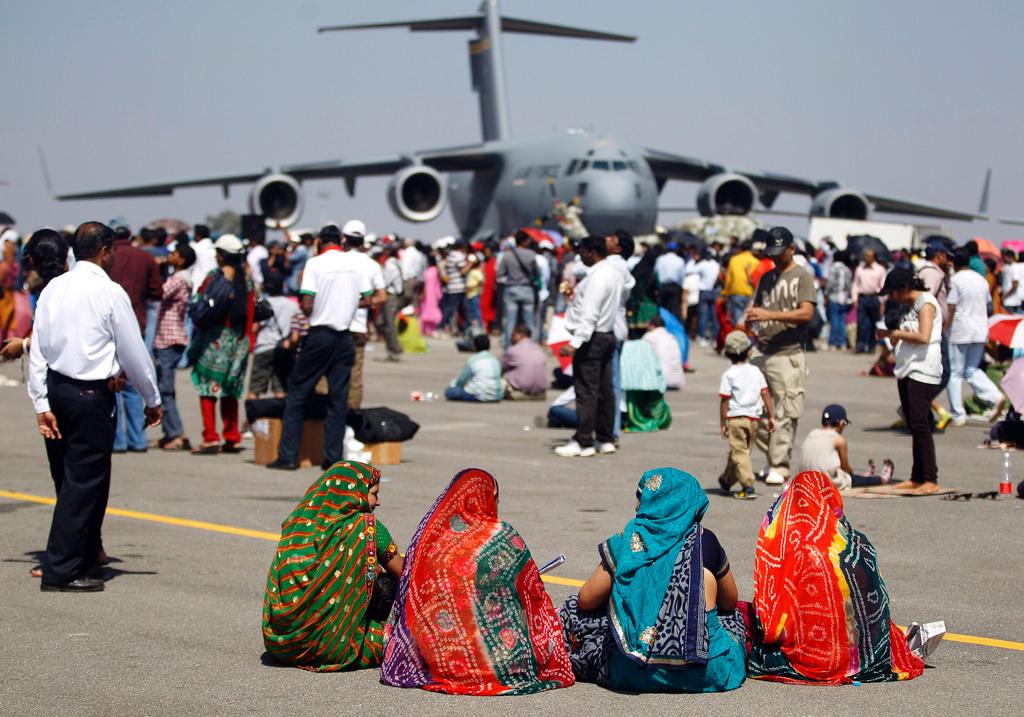Airlines scramble to satisfy India’s flying impulse

The Solar Impulse aircraft has touched down in Ahmedabad – a second-tier Indian city which exemplifies the rapid growth of air travel in India. The aviation industry is looking to boost the economy while addressing its environment footprint.
Ahmedabad’s airport registered the highest growth in international passengers (63.6%) between December 2013 and 2014 while Varanasi – which will be Solar Impulse’s second Indian stop – showed the second highest jump in domestic passengers (36.5%) during the same period.
India’s aviation sector has come a long way since the days of state monopoly over national skies. In 1993, when the government finally allowed private players to enter the domestic market, fewer than ten million travellers enjoyed a view of India’s varied landscape from an aircraft window. In 2014, seven domestic carriers transported almost 67 million passengers across the country.
The country’s domestic air travel boom has been remarkable even by international standards. The International Air Transport Association’s (IATA) Airline Industry Forecast for 2012-2016 expects the country’s domestic airline industry to show the second highest growth rate globally and become the fourth largest domestic market in the world by 2016.
Key drivers
“With private sector participation and the right policies, India would be well-placed to become one of the largest aviation markets by 2030,” Ramesh Lingamaneni, chairman of budget airline Air Costa, told swissinfo.ch. “The biggest beneficiaries of low-cost airlines would be people in tier 2 and 3 cities, small and medium businesses and the migratory work force.”
The Indian government agrees. In its report on the aviation sectorExternal link it listed some of the main drivers of future growth. An expanding middle class is definitely one of them. It is expected to more than triple from 160 million (13.6% of the population) in 2010 to 547 million (37.2% of the population) by 2025.
Another driver mentioned is urbanisation. The number of Indian cities with over a million inhabitants is forecasted to increase from 55 currently to 68 by 2030. This is bound to create demand for new airports. To respond to this potential demand, the Indian government is planning to increase the number of airports from 132 currently to 250 in 2030.
Other factors like the increase in market share of budget airlines, rise in domestic tourist numbers, government focus on remote area connectivity, sizeable working age population and rise in disposable incomes will continue to contribute to the growth of the sector.
Benefits to the economy
“There is a rare convergence of political will, social aspiration and business interest in India which will propel the growth of Indian economy,” Charles Dhanaraj, professor of Strategy and Global Leadership at the IMD business school in Lausanne, told swissinfo.ch.
“One would expect the aviation market to grow to aid this growth,” he added.
According to a reportExternal link commissioned by IATA, the economic footprint of the Indian aviation industry is quite significant. In 2009 alone, the sector contributed INR 330 billion (CHF 5.1 billion) to India’s GDP (0.5%) and paid over INR 104 billion in taxes. It also employed over 1.7 million people, including the entire aviation supply chain.
The Indian government’s Department of Industrial Policy and Promotion lists air transport as an important source of foreign direct investment (FDI) bringing in $562 million (CHF539 million) worth of foreign capital since 2000. This is bound to increase considering the government now allows up to 49% FDI in domestic airlines and up to 100% FDI in new airports.
Domestic tourism has also benefited from the expansion of the aviation industry. The steady rise of domestic tourists corresponds with the liberalisation of the airline sector in 1993. If the spill over benefits of tourism are included, aviation’s contribution to India’s GDP rises from 0.5% to 1.5%.
Environment footprint
While the economic footprint of the growing domestic airline sector is significant, so has its environment footprint. A 2013 government reportExternal link estimates the carbon footprint of domestic flights to be almost 6.4 million tonnes of CO2, an increase of 3.5% over the year before. Given the growth of the sector and demand for airline fuel, CO2 emissions are projected to increase to 11 million tonnes by 2020.
While it is inevitable that overall emissions are bound to increase, there are promising signs that new and more efficient fleets can help minimise the impact of rapid growth. In 2013 alone, CO2 emissions per aircraft movement decreased by 0.22% and emissions per passenger by 2.86%.
Fuel accounts for almost half of an airline’s total operating costs in India and has been blamed for pushing some domestic carriers to shut shop. Therefore, airlines are motivated to reduce emissions as long as it helps them to save on jet fuel, which is also heavily taxed in certain Indian states.
Measures like only using a single engine to get to the runway from the terminal in order to use less fuel are being adopted by certain airlines. Better flight planning and aircraft weight reduction are other fuel-saving options being trialled. Nothing revolutionary like Solar Impulse but small, practical steps that will help India move towards a more environmentally sustainable future.
In fact, in his musings on Virgin’s Future of Travel seriesExternal link, Solar Impulse founder Bertrand Piccard, admitted that we shouldn’t be expecting solar-powered jumbo jets anytime soon. Instead he is more optimistic about incremental changes towards a cleaner aviation sector.
“Meanwhile, we’ll witness the emergence of cleaner aviation: lighter airplanes, more direct routes, constant descent approaches, and electric motors.”

In compliance with the JTI standards
More: SWI swissinfo.ch certified by the Journalism Trust Initiative



You can find an overview of ongoing debates with our journalists here. Please join us!
If you want to start a conversation about a topic raised in this article or want to report factual errors, email us at english@swissinfo.ch.